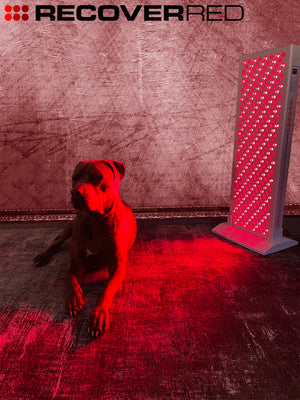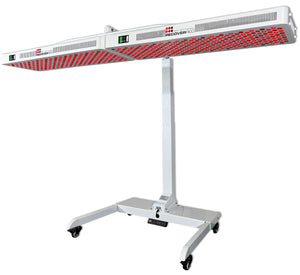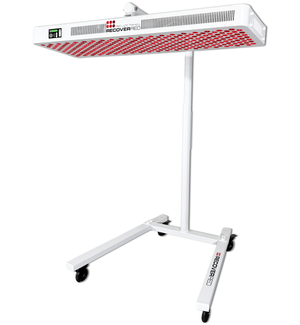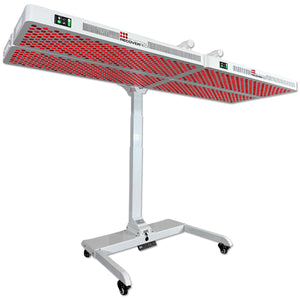Red light therapy has been around for a while as an emerging treatment, but it is now gaining attention because of its effective uses in treating numerous health conditions, like healing wounds, treating acne, and improving the appearance of wrinkles. Since red light therapy is becoming increasingly popular, one of the most common questions we get about red light therapy is, “is red light therapy safe to use?”
In this article, we will discuss how red light therapy works and what the research says about the safety of red light therapy.
What is Red Light Therapy, and How Does it Work?
Red light therapy, aka low-level laser light therapy, is a non-invasive therapy that treats a wide range of health conditions by delivering different levels of red light to your skin where the cells absorb and use it. Red light therapy uses red and near-infrared (NIR) wavelengths because different body cells and tissues respond best to these wavelengths [1].
Red light therapy, also known as photobiomodulation, offers therapeutic effects at the cellular level by penetrating the skin and activating the skin's natural healing system. A special red light device is used, having a range of 660-810 nanometers, which is perfectly safe for skin cells [2].
Red light therapy has been proven too:
- Stimulate wound healing
- Diminish acne scars
- Improving the production of collagen and elastin
- Alleviating back pain
- Boosting the immune system
- Improving brain function
- Lowering inflammation
Is Red Light Therapy Considered Safe?
Red light therapy devices use low levels of red light wavelengths to penetrate the skin without damaging it. So, red light therapy is generally safe for most people with little to no side effects. Unlike the harmful ultraviolet (UV) light from most devices, red light therapy emits safe wavelengths of red light.
What Does Scientific Evidence Say About Its Safety?
According to a placebo-controlled trial published in the Journal of Photomedicine and Laser Surgery, photobiomodulation has been reported to enhance skin rejuvenation and collagen production safely and effectively [3].
Another 2018 study published in the Clinical and Aesthetic Dermatology demonstrated that phototherapy devices using red and blue wavelengths of light exhibit an excellent safety profile for treating a range of medical and aesthetic conditions [4]
Another study published in 2013 reported that using low-intensity laser light for treating wrinkles, acne, acne scars, and burns had been proven effective and safe. The safety and non-invasiveness of red light therapy have attracted the attention of many researchers [5].
In a study conducted by Tafur et al., the enthusiasm for low-intensity light therapy continues to increase because of its clinical safety and efficacy [6].
Therefore, more research and clinical trials are being conducted to confirm the safety of red light therapy as a treatment.
The Bottom Line:
Red light therapy has been playing a pivotal role in the treatment of many skin conditions. The treatment involves using a light-emitting diode (LED) that emits low-intensity, red, and near-infrared wavelengths of red light to promote the body's natural healing mechanism at the cellular level. Red light therapy devices are generally considered safe to use; however, more research is needed to confirm the long-term safety of red light therapy.
References:
[1] Hamblin MR, Demidova TN. Mechanisms of low-level light therapy. Proc.SPIE, vol. 6140, 2006.
[2] Wunsch A, Matuschka K. A controlled trial to determine the efficacy of red and near-infrared light treatment in patient satisfaction, reduction of fine lines, wrinkles, skin roughness, and intradermal collagen density increase. Photomed Laser Surg 2014;32:93–100. https://doi.org/10.1089/pho.2013.3616.
[3] Ablon G. Phototherapy with light emitting diodes: Treating a broad range of medical and aesthetic conditions in dermatology. J Clin Aesthet Dermatol 2018;11:21–7.
[4] Avci P, Gupta A, Sadasivam M, Vecchio D, Pam Z, Pam N, et al. Low-level laser (light) therapy (LLLT) in skin: Stimulating, healing, restoring. Semin Cutan Med Surg 2013;32:41–52.
[5] Tafur J, Van Wijk EPA, Van Wijk R, Mills PJ. Biophoton detection and low-intensity light therapy: a potential clinical partnership. Photomed Laser Surg 2010;28:23–30. https://doi.org/10.1089/pho.2008.2373.




